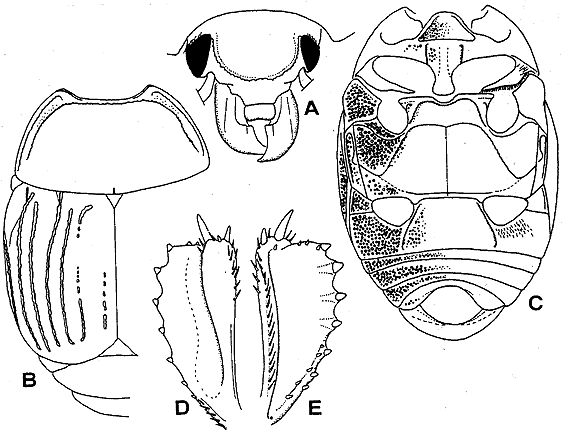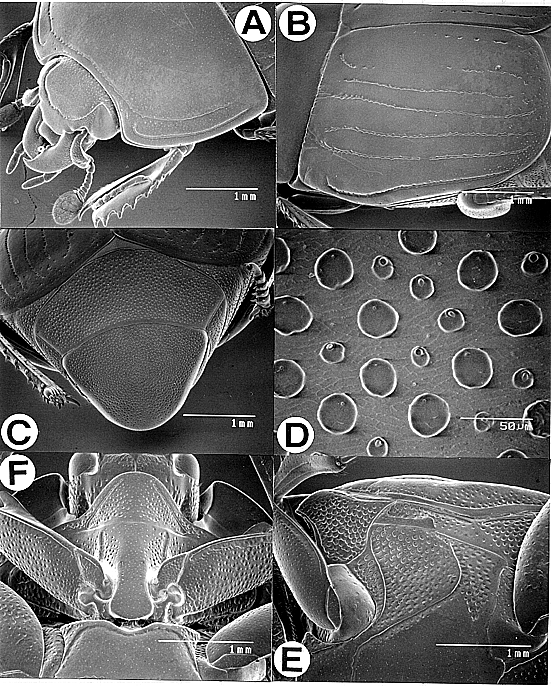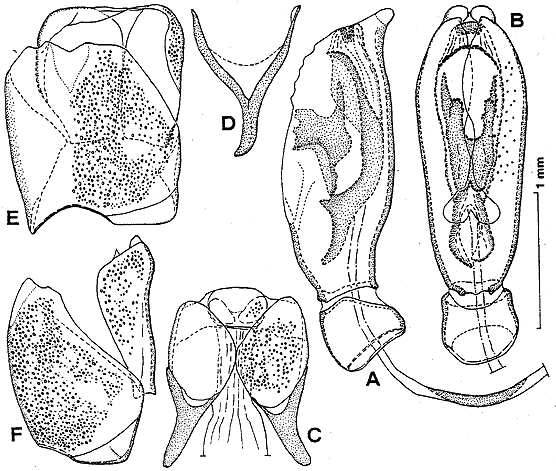
Original description (Ohara, 1999).
Type material. Holotype (SEHU). Male. Point-mounted; genitalia dissected; genitalia in balsam on a plastic slide; labeled as follows: 1. Songkang (alt. 2,000 m), Nantou Hs. (= Hsien), Taiwan, 2 VIII 1992, Chin-Kin Yu leg.; 2. M. Ohara, No-9917; 3. Holo-type, Margarinotus (Ptomister) osawai M. Ohara (red label).
Description. Body length, PPL 6.45 mm, PEL 5.60 mm. Width, 4.55 mm. Biometric data are as follows: PL 2.05, APW 1.75, PPW 4.00, EL 2.90, EW 4.55, ProW 2.80, ProL 1.10, PL 1.25, PTL 1.50, MSTL 1.50, MTTL 2.05. Body oblong-oval, black and shining.
Frontal stria of head (Fig. 13A) complete and well impressed, and bent slightly inwards at middle; disk sparsely and finely punctate, the punctures separated by about four times their diameter.
Marginal pronotal stria (Fig. 13B) complete laterally, and broadly interrupted behind head. Outer lateral stria nearly complete. Inner lateral stria complete and strongly crenate, straight on the apical portion. Disk of pronotum evenly and finely punctate, the punctures separated by two to five times their diameter and becoming coarser between two lateral striae. Antescutellar area with a longitudinal punctures.
Epipleural fossette feebly excavate and densely covered with large punctures. Marginal elytral stria absent. Marginal epipleural stria complete and with large punctures. External subhumeral stria (Fig. 13B) deeply impressed and abbreviated at basal sixth. Internal subhumeral stria absent. Oblique humeral stria present on basal third. First to 4th dorsal striae complete and feebly crenate, but 2nd and 4th striae shortened on apical ninth and eighth, respectively; basal end of 2nd bent slightly outwards. Fifth dorsal stria present on apical third and as a short arc on basal sixth. Sutural stria represented by a line of a few punctures on apical half. Disk of elytra with a subapical depression. Surface of elytra evenly and finely punctate, the punctures becoming coarser on apical band.
Propygidium (Fig. 14C) densely covered with coarse punctures, which are separated by half to three times their diameter, with a few moderately sized punctures intermingled. Pygidium more densely punctate than propygidium, the punctures minute at apex.
Prosternal lobe (Fig. 13C, 14F) round at apex, its marginal stria broadly interrupted at middle. Disk of lobe coarsely punctate, the punctures becoming denser laterally. Prosternal keel without carinal stria.
Anterior margin of mesosternum (Fig. 14F) emarginate at middle, its marginal stria complete and subcariniform, and another short stria present behind each anterior angle. Disk of mesosternum sparsely covered with fine punctures, which are separated by about five times their diameter. Meso-metasternal suture obtusely angulate at middle. Lateral metasternal stria (Fig. 14E) well impressed and carinate, extending obliquely and posteriorly, and united with the oblique stria that extends inwards form the middle of the metasternal-metepisternal suture. Post-mesocoxal stria extending along the basal margin of mesocoxa and its outer end attaining to middle of metasternal-mesepimeral suture. Intercoxal disk of metasternum sparsely clothed with fine punctures, and feebly depressed along the longitudinal suture. Lateral disk of metasternum densely covered with large and shallow punctures, which are separated by half or one-third of their diameter and become finer posteriorly, intermingled with fine punctures; without hair.
Intercoxal disk of 1st abdominal sternum with sparse fine punctures, which become coarser along the 1st abdominal stria. First abdominal stria complete and deeply impressed.
Protibia (Fig. 13D, E) with 7 denticles on outer lateral margin and 3 small denticles on apical margin. Ventral surface of profemur with posterior marginal stria on apical fourth.
Male genitalia as shown in Fig. 15. Ratio in length of paramera to basal piece of aedeagus 3.87.
Distribution. Taiwan (Highlands).
Remarks. M. osawai is close to M. agnatus (Lewis). It may be distinguished by the shape of madian armature of male genitalia (Fig. 15A, B).
This species is named in honour of Dr. Shozo Osawa, who is one of pioneers in Japanese histeridology.

Fig. 13. Margarinotus (Ptomister) osawai M. Ohara, n. sp. A: Head, frontal view. B: Pronotum and left elytron. C: Ventral side of adult. D: Left protibia, dorsal view. E: Ditto, ventral view. [A-E: no. 9917, Holotype, Sungkung].

Fig. 14. Margarinotus (Ptomister) osawai M. Ohara, n. sp. A: Head and pronotum, oblique view. B: Left elytron, oblique view. C: Propygidium and pygidium, caudal view. D: Punctation of pygidium. E: Prosternum, ventral view. F: Mesosternum, metasternum and epipleura of elytron, ventral view. [AF: no. 9917, Holotype, Sungkung]. (Ohara, 1999).

Fig. 15. Margarinotus (Ptomister) osawai M. Ohara, n. sp. Male genitalia.
A: Aedeagus, dorsal view. B: Ditto, lateral view. C: Ninth and 10th tergites,
dorsal view. D: Ninth sternum (spicule), dorsal view. E: Eight tergite and
sternum, dorsal view. F: Ditto, lateral view. [no. 9917, Sungkung]. (Ohara,
1999).